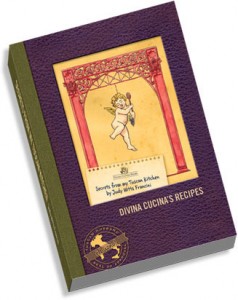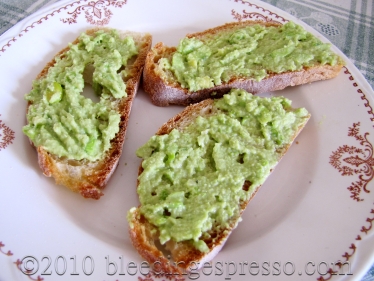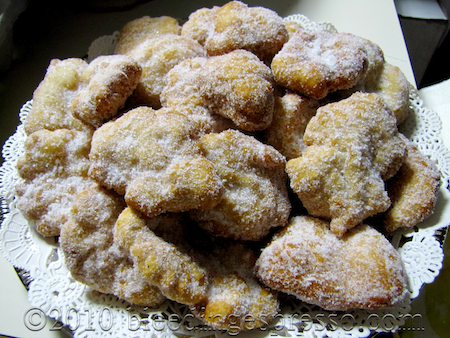Archive for the ‘food’ Category
What’s Cooking Wednesday: Fava Bean Spread
When we get fava beans, we tend to get them by the kilo…several kilos.
We usually just eat them either raw or cooked with Calabrian sausage, but this year I was determined to do something different. Somehow I got the idea in my head to make a fava-based hummus. I love chickpea-based hummus, which I make here despite the lack of tahini, so I gave it a go.
I really enjoyed it, so I’m posting the recipe in case you’d like to try it too.
Some notes before beginning:
- The measurements in this recipe are estimates (although I am usually pretty good at estimating, so do feel safe in using them as general guidelines). Even if I did measure things exactly, though, amounts are going to differ by personal choice, so use your judgment. I trust you!
- This recipe makes enough fava spread for about five slices of bread, the size of which you can see in the photo (each slice sits comfortably in my hand with outstretched fingers). For two people as an appetizer or snack this is a great amount; the mixture probably isn’t going to keep very long in your fridge, so I don’t know how much leftover you really want to make.
- The spread might be even better after sitting for just a little while to let the flavors merge, but I wouldn’t say to leave it more than a day or two. When I make hummus and put it in the fridge, it’s not very appetizing after just two days.
- After I made this, I then looked online for similar recipes. I know. Cart before the horse and all. I see that many blanch their favas before making a spread with it. If you want to do that just give them a dip in boiling water for about 30 seconds and then proceed with the mashing. I think this may be mainly to get the external shell off and make digestion easier, but you can just remove it yourself while they’re raw and keep all the nutrients intact to boot. That’s my recommendation, unless you have particularly hard favas that you think won’t mash well. Judgment time again!
- I added the peanut butter to this recipe because I thought it still needed *something*; if you have tahini, you can certainly try that. You can also try it without the peanut butter or tahini, of course.
- If you play around with this recipe, please let me know. I think it’s a great base spread that can go many different ways, and I’d love to hear your suggestions! This would also be great with some other stuff layered on top or bottom from sardines to ricotta cheese to diced tomatoes. Mmmm.
Fava Bean Spread
- Fresh shelled favas from about 20 medium to large pods
- 1 small clove of garlic, minced
- 3 tablespoons olive oil (just enough to give it some moisture, not make it oily)
- 2 teaspoons peanut butter
- 3 squeezes of lemon juice
- Salt to taste
1. Puree together all ingredients to your desired level of smoothness; I like mine a little chunky.
2. Taste for what’s off/missing and adjust.
3. Spread on toast, fresh bread, crackers, grilled meats, raw veggies, whatever you like!
Buon appetito!
L’Uovo di Pasqua: The Italian Easter Egg
Easter in Italy is generally much less commercialized than in the United States, but there is one tradition that recalls the Easters I knew growing up:
L’uovo di Pasqua. The Italian Easter Egg.
As you can tell from the photo, these are not those little bite-sized, even two or three bite-sized eggs you’re using to seeing. These are hollow and range in size from palm of your hand to ginormous (think: wrap your arms around it to carry it).
I bought some yesterday just to show you what an egg looks like wrapped and unwrapped:
Then since it was open, well, we had to smash it, because the eggs usually have a “sorpresa” (surprise) inside. Depending on how much you paid for your uovo di Pasqua, your surprise could be a dinky little toy or something more substantial, but still a toy nonetheless.
Having spent a whopping €1,50 ($2) on each one of these, we got dinky. And here’s P putting the stickers on the pathetic plastic car:
Stylin’ when it’s done, though, isn’t it? “Collect them all!” says the insert.
And in case you’re wondering, there’s no Easter Bunny and definitely no marshmallow stuff or jelly beans. Thank goodness for my mom! I love jelly beans, and now so does P.
Buona Pasqua to those who are celebrating!
Peas with Pancetta Plus Divina Cucina’s Secrets from a Tuscan Kitchen Cookbook
 My friend Judy Witts Francini kindly sent me a copy of her handcrafted cookbook, Secrets from My Tuscan Kitchen, and has even more kindly offered to give a lucky Bleeding Espresso reader a chance to win a copy as well.
My friend Judy Witts Francini kindly sent me a copy of her handcrafted cookbook, Secrets from My Tuscan Kitchen, and has even more kindly offered to give a lucky Bleeding Espresso reader a chance to win a copy as well.
To enter the random drawing, all you need to do is comment on this post by 11:59 pm (CET) on Tuesday, March 30, 2010.
Trust me, you’re going to love this cookbook. Not only is it absolutely full of tasty recipes from appetizers to desserts, Judy’s cookbook is also aesthetically pleasing and a cook’s best friend with each page facing the recipes blank so you can add your own notes.
If you don’t know, Italian cooking is very regional, i.e., what you’ll find in Calabria, you probably won’t find in Piemonte, and vice versa. So for those of you who want to get a great taste of what eating in Tuscany is like, you must see Judy’s cookbook, which is based on her own experiences of living in the region for nearly 30 years, particularly as influenced by her Tuscan mother-in-law.
You can read more about Judy’s cookbook and how you can order your own at Judy’s website, Divina Cucina. You can also keep up with Judy at her blog Over a Tuscan Stove and on Twitter @divinacucina.
Of course I wanted to share a recipe with you as I shared Judy’s book this What’s Cooking Wednesday, so I chose something I knew that would be a big hit here. Judy has two recipes for peas in the book, one with pancetta (Piselli alla Fiorentina) and the other with cooked ham (Piselli al Prosciutto); I actually ended up combining the two recipes to adjust for what I had handy (ran out of garlic!), but what I made was closer to Piselli alla Fiorentina, so here you go.
Ah, also, I did leave out the sugar, as P freaks out when he tastes sugar. The peas were definitely sweet enough, and this dish was delicious…and talk about easy peasy! Sorry, couldn’t resist.
Piselli alla Fiorentina
- 1 lb peas
- 2 oz pancetta, cubed
- 1 clove garlic, sliced
- 2 tbs chopped parsley
- 1 tbs sugar
- Salt
- 8 tbs olive oil
1. Place peas, garlic, parsley and olive oil in a saucepan. Add salt to taste.
2. Add enough water to cover peas.
3. Cook over low heat, covered.
4. Just before the peas are done, add the pancetta and sugar. Serve with their sauce.
Buon appetito!
Remember to comment for your chance to a win a copy of Judy’s cookbook!
Calabrian Zeppole di San Giuseppe for Italian Father’s Day
Today is La Festa di San Giuseppe or St. Joseph’s Day. Here in my corner of Calabria, we celebrate with “i zippoli” or le zeppole, which are quite different from what some of you know as zeppole, but we’ll get back to that in a moment.
This is what ours look like:
That photo was taken on Christmas Eve in the United States after my mom and I whipped these up for the traditional family get-together at my dad’s house. Why zeppole on Christmas Eve, you ask?
Well because these little guys are *huge* family favorites — think legendary status — and I had a sinking feeling that no one on that side of the Atlantic had tasted their goodness since my grandmother passed away in 2001.
My intuition was right, and these were a big hit, gone rather quickly, and the source of many happy memories floating around my grandmother’s old house. Even the Russians in attendance had to ask how to make these babies.
Well, you don’t have to ask as I’ve already posted the recipe at Calabrian Zeppole.
You can read more about today’s holiday, what fava beans have to do with it, and the different types of zeppole throughout Italy at Fava Beans and Cream Puffs.
And if you want to know how to handle those favas and what to make with them, check out Calabrian Sausage and Fava Beans.
And hey, if you’re feeling a bit adventurous, why not take some vacation days, compare flights, and hop a plane in time for some zeppole? I’ll save you some. Probably. Hurry!
Now if you’ll excuse me, it’s time to get snapping, literally, as I get my fava on.
Auguri to all the Giuseppes and Giuseppinas!
And buon weekend a tutti!
Borlotti Beans: Facts and Recipes
Borlotti beans are one of the staples of our diet in my house in Calabria, so it’s about time we talked more about them, don’t you think?
Borlotti beans are also known as cranberry beans or French horticultural beans and are some of the cutest darn beans around if you ask me.
Don’t get too excited about how festive they look, though, as that color goes away with cooking. They eventually turn brown.
What do they taste like? I’m not a bean expert or anything, but to me, borlotti beans taste most like what those of us who enjoy baked beans are used to having. They’re meatier than your average white cannellini bean, aren’t at all sweet, and hold up *extremely* well with tomatoes in particular. I speak from experience (we’ll get to that in a minute).
Here you can find borlotti in all kinds of ways–dried, fresh, jarred, canned. If you get the dried version, you’re going to have to soak them overnight before using them.
And they’re good for you! They’re high in protein (23.03g in 100g dried) and fiber (24.7 g). See more nutritional information at (where else?!) Borlotti.com.
So now I’m sure you’re wondering what to do with these loverlies. Well, they’re great in just about any type of dish from soups and stews to cold salads, so I do encourage you to use your imagination.
For some guidance, though, I posted a recipe a very long time ago, my very first recipe ever posted in fact, so you may have missed it:
Borlotti Beans with Tomatoes, Garlic, and Basil
We eat this literally once a week here throughout the winter, so it comes *highly* recommended.
For some other ideas on what to do with borlotti, check out what some of my blog friends have shared:
- Barbecue Baked Beans with Bacon at Sara’s Ms Adventures in Italy
- Braised Borlotti Beans with Red Peppers, Parsley, and Berbere Spice at Ilva’s Lucullian Delights
- Cowboy Beans with Smoked Sausage at Jenn’s The Leftover Queen
- Cranberry Beans, Kale, and Sausage Stew at The Passionate Palate
- Minestrone with Fresh Borlotti Beans and Farro at Susan’s Porcini Chronicles
What is your favorite bean dish, borlotti or not?

























